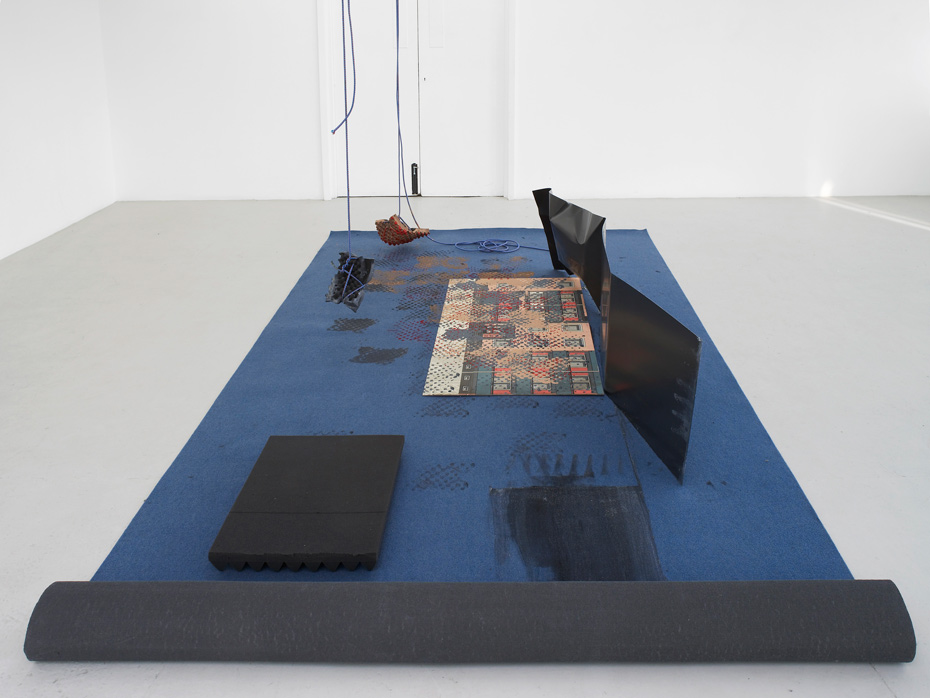William Kherbek looks at the woven narratives of Nora Schultz’ Rugs at Campoli Presti

Ready for some side-splitting hilarity? No? Well, you were warned. From his perch at The Washington Post, the Great Essayist of Our Age, Richard Cohen once opined, apropos of a report by Iran to the International Atomic Energy Agency, “These Persians lie like a rug.” Even repeating it now, three years on, I slipped into a state of comic ecstasy and am only now regaining control of my faculties. Jim Morrison says ‘hi’. Rarely has warmongering propaganda involved such punnery. I note Cohen’s application for a seat at the Algonquin Round Table on the occasion of a much more interesting interrogation of rugs by the artist Nora Schultz at Campoli Presti gallery. As Cohen’s sub-Zappa wordplay suggests, rugs have a bad reputation for lying, but in Schultz work, they have an interesting way of telling some home truths about the world we live in.
A few years ago, I was at one of Ed Fornieles’ installation/performance/saturnalias wherein every manner of debauchery manifested itself. After the performance, when things were getting cleaned up, someone remarked that the rug beneath our feet, stained with everything from shaving cream to cheap American beer to blood, was as much an artwork as the installation. It was a prescient remark; anyone who’s ever attempted to get a stain out of a rug knows how hard it is to remove the traces of human mistakes from the most domestic of fabrics. In Schultz’s show this dynamic is, Richard Cohen would write, woven into the narrative of each work, but Schultz keeps things from getting too anthropocentric by using newish carpet, an interesting and apposite choice, especially in works like City Sound of a Rug wherein a stained rug substitutes for a cityscape, or in the strangely romantic Nature Piece which turns carpet, foam packing, and fragments of metal into landscape. Nature Piece in particular contains multitudes. On one level, it’s a wry commentary on relationship between landscape and representation.
This pile of manufacturing detritus is no more or less redolent of an illusory, anthropic vision of nature than anything Caspar David Friedrich would have made. On a deeper level, there’s a kind of emergent requiem for the natural world. The advance of climate change and the looming tipping point at which more humans will live in urban than in rural environments make the retreat of organic nature from our quotidian experience more than just a matter for aesthetic chin-strokery, it’s a reification of the circular “march of progress”. It’s also every fort built by a child in the living room using sofa cushions and throw rugs as battlements and moats. Schultz is particularly deft at creating unstable, unresolved chains of reference with her rugs. In Rug Memory Printer the piece morphs from seascape to constructivist homage to industrial mishap and back in the space of seconds. Rug Import also offers one of the better uses of the gallery space at Campoli Presti in a while. There’s a low-fi but palpable tension between the works themselves and it points toward another property of rugs, their capacity to define how a room’s space is perceived. Schultz isn’t going for James Turrell-style mind’s eye tricks, just a simple assertion of presence that at once announces the space’s dimensions and alters them. No one would accuse these rugs of lying, but they tell their stories on their own terms. Oh God, I’m turning into Richard Cohen. Please help me.
Nora Schultz: Rug Import runs until 28 March at Campoli Presti, 223 Cambridge Heath Road, London E2 0EL




